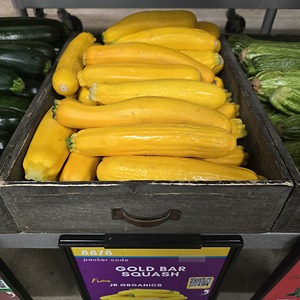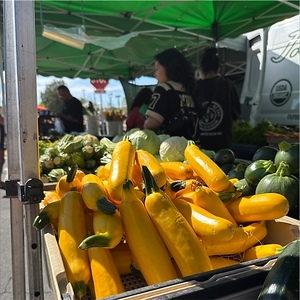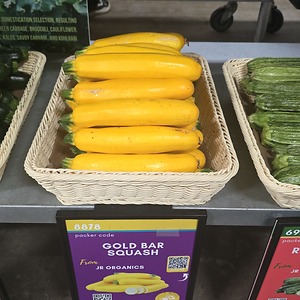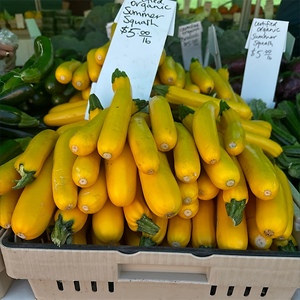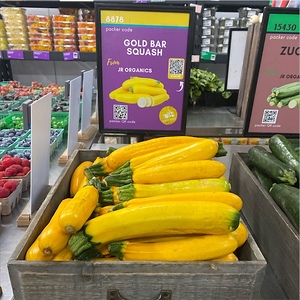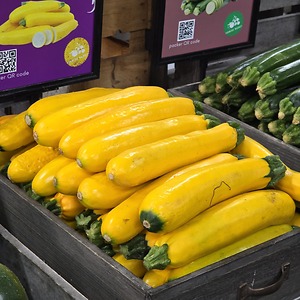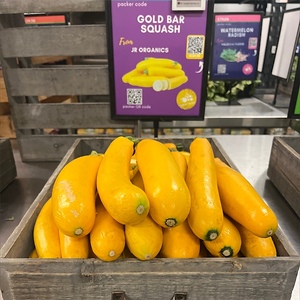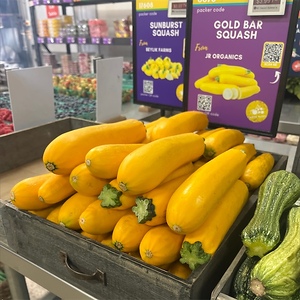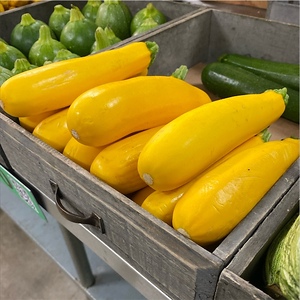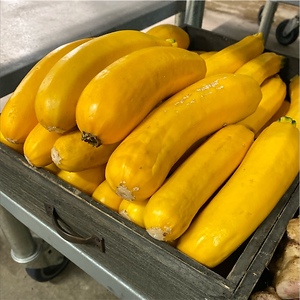


Gold Bar Squash
Estimated Inventory, 22 lbs : 0
Description/Taste
Gold Bar squash is a slender summer variety distinguished by its bright, golden-yellow color and shiny, smooth texture. Its skin is often accented by subtle pale yellow striping along its length. This thin, tender skin is edible and nutrient-rich, eliminating the need for peeling. The squash features a vibrant green cap at both its blossom end and stem. The interior reveals creamy white flesh that is firm yet succulent, surrounding a small, moist seed cavity. Gold Bar squash emits a mild, subtly sweet aroma, less intense than other summer squashes, with a fresh vegetal scent reminiscent of cut grass or cucumbers. The flavor of Gold Bar squash is milder and sweeter than zucchini, offering a nutty, grassy, and delicately sweet taste both raw and cooked.
Seasons/Availability
Gold Bar squash is available year-round with a peak season in the summer months.
Current Facts
Gold Bar squash, scientifically known as Cucurbita pepo, belongs to the Cucurbitaceae family, which also includes cucumbers, zucchini, watermelons, pumpkins, and gourds. Gold Bar squash is often referred to as yellow zucchini due to its similar shape, culinary versatility, growing conditions, and comparable taste and texture. Like its relatives, the Gold Bar squash plant features a nectary disc—a specialized structure that produces nectar to attract pollinators, essential for fruit development. The seeds of this squash are encased in a mucilaginous coating that becomes slimy when wet, a trait that enhances adherence to surfaces and potentially aids in seed dispersal by animals. Although categorized as a summer squash, Gold Bar squash thrives year-round, necessitating regular harvesting to boost yields and prevent the squash from growing excessively large overnight. For the best flavor and texture, harvest these squash when they are young, as their seeds are less developed and the flesh is particularly tender. To harvest, use a sharp knife or garden clippers to cut the squash from the vine, making sure to include a generous portion of the stem. This technique helps seal the fruit, maintaining its moisture and freshness while protecting against mold.
Nutritional Value
Gold Bar squash is high in Vitamin C, an antioxidant that can help prevent oxidative stress and boost the immune system. This vitamin plays an important role in collagen production, enhancing the health of joints, skin, and hair. Gold Bar squash is abundant in phenolic compounds and a variety of carotenoids, including beta-carotene, zeaxanthin, dehydroascorbic acid, and lutein. Beta-carotene, once converted into vitamin A in the body, is crucial for maintaining skin health, bolstering immune function, supporting eye health, and preserving the integrity of mucous structures such as the heart and artery linings. Zeaxanthin and lutein, concentrated in the retina's macula, are vital for protecting the eyes from light-induced oxidative damage, potentially warding off macular degeneration and cataracts. These carotenoids neutralize free radicals, reducing cellular damage and oxidative stress, which are linked to chronic diseases and signs of aging. Diets rich in carotenoids correlate with a lower risk of cognitive decline, as these nutrients are believed to enhance brain function and diminish inflammation, making them especially beneficial in mitigating age-related cognitive impairments and memory loss.
Applications
Gold Bar squash can be eaten raw, sautéed, grilled, fried, pickled, steamed, or hollowed out and stuffed for baking. This squash can be a substitute in recipes calling for zucchini or any other variety of yellow summer squash. When raw, it can be thinly sliced or spiralized for pasta and salads, grated into a vegetable slaw with carrots, cabbage, and bell peppers, or used as a crunchy dipper for hummus and guacamole. Gold Bar squash can be layered with vegetables in a savory grain dish, lasagna, or ratatouille. For a nutritional boost, grate it into dough for breads and muffins. Gold Bar squash can be a topping for pizzas, flatbreads, rice dishes, or Mediterranean sides. Gold Bar squash complements the flavors of asparagus, mushrooms, lemon, eggplant, tomatoes, garlic, corn, roasted meats, and cheeses like feta, chevre, and ricotta. It also pairs well with fresh herbs such as oregano, thyme, and basil. Though Gold Bar squash bruises easily and is best used fresh, it can be stored for up to a week in a cool, dry place.
Ethnic/Cultural Info
Golden squash varieties, such as the Gold Bar, were pioneered in the United States, largely thanks to the efforts of Dr. Oved Shifriss. A notable plant breeder, Dr. Shifriss made significant contributions to the development of various hybrid squashes, with a focus on enhancing traits like color, size, and disease resistance. His work led to the creation of new golden squash varieties that were better adapted for commercial production. Squash has a deep-rooted history in human civilization, with evidence of squash seeds dating back 12,000 years found in Ecuadorian caves. In the Americas, squash was one of the three staple crops, alongside maize and beans. Known as the "Three Sisters" by the Iroquois, these crops were cultivated together in a symbiotic relationship. Corn provided a support structure for climbing beans, while the beans stabilized the corn stalks against wind and rain and enriched the soil with nitrogen, benefiting all three crops. Squash vines served as a natural mulch, shading out weeds and preserving soil moisture, while their prickly stems prevented pests from interfering with the harvest.
Geography/History
Though the Cucurbita family is native to the New World, golden squash varieties including Gold Bar only started emerging in the commercial marketplace during the 1970s. This variety thrives in warm, temperate climates and is not found in the wild but rather cultivated in controlled environments such as commercial farms and home gardens. Specifically bred for its desirable traits like size, flavor, and vibrant golden color, Gold Bar squash has become popular for its prolific growth and adaptability to various growing conditions. It produces abundantly, has a relatively short growing cycle from planting to harvest, and offers both a consistent appearance and culinary versatility, all of which have boosted its presence in the market. You can find Gold Bar squash at farmers' markets, grocery stores, and in home gardens, particularly during its peak season in summer.
Recipe Ideas
Recipes that include Gold Bar Squash. One



